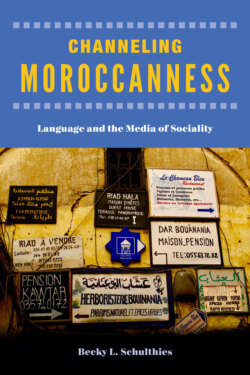Читать книгу Channeling Moroccanness - Becky L. Schulthies - Страница 8
Introduction
ОглавлениеMoroccan Channels, Channeling Moroccanness
الحلقة ١: التسبيح الالكتروني
Episode 1: Remote Control Prayerbeads
I daily found myself part of early evening assemblages in Fassi homes,1 gathered around a table with partially consumed flatbreads, jam, cheese, sweets, boiled eggs, half-full tea glasses, and a television. My Fassi interlocutors called this routinized event casse-croute,2 or التاي, atāy—a time to unwind from the day’s labors and reaffirm sociality bonds with family, neighbors, and friends through food and conversations about any- and everything. Though anthropologists have written how French colonial work schedules (Kapchan 1996, 154–55), café culture (Graiouid 2007), media technologies (Davis and Davis 1995), and citizen-consumer aspirations (Newcomb 2017, 116–20) have shaped Moroccan tea gatherings, some Fassi families preserved this as an important vestige of Moroccan heritage—how their mothers, grandmothers, and aunts cared for and facilitated their social networks (Fernea 1975; MacPhee 2004; Mernissi 1994; Newcomb 2009). Since my first Moroccan fieldwork ventures in the early 2000s, the profound everyday quality of this recurring sociality ritual had piqued my ethnographic interest in the connections between electronic mass mediation of Moroccanness and talk about it. I learned the way to make and pour tea so that the bubbles foamed properly in the glass; the respectful ways to reach across the table and tear off appropriate bread pieces to dip in olive oil or spread with Le Vache Qui Rit cheese; how many sweets or boiled egg halves to take so as to not appear greedy; what kinds of television programs backgrounded the relaxed teatime atmosphere; and the patterns of talk that could accompany these domestic interactions.
During one particular teatime gathering I recorded and transcribed, a mother, her two teenage daughters, their male cousin, and female neighbor had been flitting across television channels and chatting for the better part of an hour. The daughters had just returned from school, the women were resting from domestic responsibilities, and the cousin was taking a break from studying for his university classes. The remote was in the hand of the fifteen-year-old daughter, who continually moved between transnational satellite stations. She had been flipping between an Egyptian music video station and a Bollywood movie channel. Her sister, mother, and older cousin each asked her to change to a different station, but she ignored their requests. No one immediately protested her disregard, conveying a sense of languid ease—being together was the purpose of watching, no matter the programming. At one point the younger sister began singing the song attached to one of the videos flashing by, and the mother clicked her tongue in exasperation. She followed this with a critique couched in a religiously significant metaphor: لا حولا ولا قوة إلا بالله (lā ḥawlā walā qūwat īlā bīllah, “There is no power or strength except in God.”) I often heard this phrase used in Fez and Morocco more generally to express awe, frustration, empathy, encouragement, anxiety, piety—a range of sentiments that could only be fixed in the context of the utterance. In this instance, the mother’s voice quality began with a breathy intake and dropped pitch rapidly as she expelled the phrase, signaling repetitive use and a tone of resignation tinged with sarcasm. She was mildly frustrated with the lack of a specific program. The younger sister further affirmed her mother’s evaluative stance toward this practice of montage viewing, extending the critique with the commonly accompanying phrase إلا بالله العلي العظيم (īlā bīllah āl’alī āl’aḍīm, “except in God the High and Great One”). She added her own subtle adjustments to meaning by furthering the downward pitch plunge and inserting a breathy mimicry. Her playful mocking of her mother’s regular use of this phrase to express frustration further layered the critique to include the speaking practices of her mother and channel surfing of her sister.
At nearly the same moment, her older male cousin jumped in with a one-word phrase telegraphing previous discussions about the media practice of flipping through stations: التسبيح (tasbīḥ). This described a religious practice whereby one continuously and repetitively moved beads, التسابيح (tsābīḥ), through one’s fingers and recited/remembered the names of God. Each movement of the hand was coordinated with praise pronouncements in the form of descriptors of God’s qualities, reinscribing the relationship between believer and worshipped. While it was not uncommon for Moroccans, especially those seeking a more expansive religious life, to fill their spare moments with the supplicatory motions of tasbīḥ, it was sometimes disparagingly regarded as perfunctory rather than refining. In other words, one could go through the motions without the practice having the right kind of transformative effects. This description of channel surfing as tasbīḥ, the cousin later informed me, he had learned from this same aunt, so he knew at least some of those present would understand his one-word evaluation. For his aunt, the thoughtlessness of devotional bead practices was doubly damaging at this moment. She quickly added that those who turn the beads say سبحان الله (subḥān āllah, “glory to God”), sometimes spending the whole day in that motion without going out of the house—just like they were doing with the remote control at that moment. The neighbor agreed with a quiet “ah.” The mother saw their repetitive motions of pressing the remote as an embodied, merely going-through-the-motions practice without intent. Here the mother also indexed how performing télécomonde tasbīḥ (prayerbead-like television remote finger motions) reproduced a relationship between believer and worshipped, between her daughter and entertainment television. This was not a passive acceptance of the practice. I understood her double-edged critique to flay both unconscious going-through-the-motions of religious practice as well as unthinking engagement of media that failed to facilitate the right kinds of sociality.
